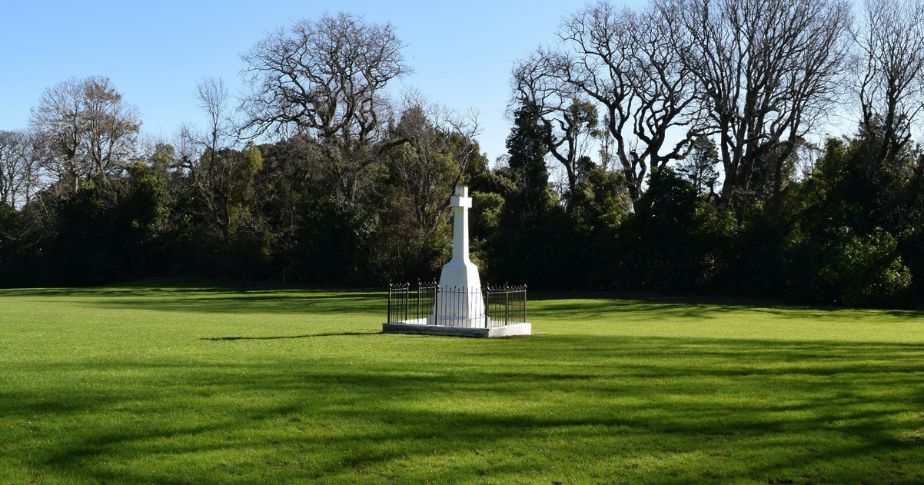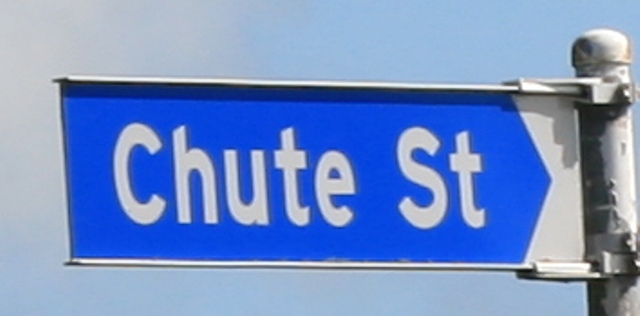In 2016 I took a trip with a family member into the nearby Taranaki district to see the site of a little known colonial land battle near the tiny township of Normanby...
Te Ngutu o te Manu. It was to be the subject of a photographic art project.
Although never admitted to, the land wars, branded Māori Wars back then, were really about a battle for sovereignty between Māori and the Crown (see pdf). A reminder of that agenda can be found in the word 'colonization' itself ... Merriam Webster defines it as:
"...to take control of (a people or area) especially as an extension of state power : to claim (someone or something) as a colony"
A more benign definition comes from the Cambridge Dictionary:
"...to send people to live in and govern another country"
We have been told however that the colonizer came to bring the benefits of civilization, or words to that effect ... and thereby any hardships suffered by way of loss of language and lands, were supposedly compensated for with civilization's trappings ... aircraft, automobiles and so on.
Read: REMEMBERING WHY EMPIRES MAKE TREATIES
The Taranaki, our destination, was the scene of vast land confiscations from those iwi that declined to sign the Treaty at Waitangi, and who would not sell. This stance inevitably classed them as 'rebels'!
They lost one million acres in all, with a total of six million confiscated NZ wide. This particular Pa site, Te Ngutu o te Manu, translated The Beak of the Bird, was about an hour and a half's drive from where I lived in the Horowhenua. In 1868 it had suffered an assault by colonial forces that actually turned into a major victory for Māori with a loss of 18 lives by the colonials. You can read a brief description of the battle at this link, a longer version here.
Heading North West from the Horowhenua, up the coast and inland to Normanby, we made a short stop at Whanganui to see the grave and memorial to John Ballance, a former NZ PM, also original founder and editor of the local newspaper, the Wanganui Herald, now the Whanganui Chronicle. Ballance was infamous for his racist views and is on record as saying 'the only good Māori was a dead one'. This is reminiscent of Colonel Chivington in Turtle Island (the USA) who expressed similar views about Indians. 'Nits make lice' he said, 'kill 'em all'. SOURCE
In justification for their genocidal activities, President Roosevelt had said that:
"The most ultimately righteous of all wars is a war with savages. … American and Indian, Boer and Zulu, Cossack and Tartar, New Zealander and Maori,—in each case the victor, horrible though many of his deeds are, has laid deep the foundations for the future greatness of a mighty people". SOURCE
Such statements ought to put to rest any rhetoric about bringing a benevolent civilization to so called savages. As the late John Trudell said:
“The great lie is that it is civilization. It’s not civilized. It has been literally the most blood thirsty brutalizing system ever imposed upon this planet. That is not civilization. That’s the great lie, is that it represents civilization.”
 Ballance's statue now takes pride of place outside the Whanganui District Council buildings, the former statue having been defaced and removed from Pakaitore grounds during an occupation there in the '90s. Whanganui's Dame Tariana Turia (former Māori Party co-leader) was censured and made to publicly apologize for a speech delivered to the NZ Psychological Society Conference 2000 (Waikato University, 29/8/2000) in which she described the colonization of the world's indigenous peoples as a 'holocaust'. She writes about Ballance in her revealing book, Crossing the Floor, and quotes from James Belich's book 'I Shall Not Die', where Ballance is described as being 'vehemently anti-Māori' (p 69). He 'even looked with disdain' writes Turia, 'on Maoris friendly to Europeans and was alleged to have taken part in the killing of a respected elderly Māori woman'. (Leahy, Helen. Crossing the Floor, (Leahy, Helen. Crossing the Floor, Kindle).
Ballance's statue now takes pride of place outside the Whanganui District Council buildings, the former statue having been defaced and removed from Pakaitore grounds during an occupation there in the '90s. Whanganui's Dame Tariana Turia (former Māori Party co-leader) was censured and made to publicly apologize for a speech delivered to the NZ Psychological Society Conference 2000 (Waikato University, 29/8/2000) in which she described the colonization of the world's indigenous peoples as a 'holocaust'. She writes about Ballance in her revealing book, Crossing the Floor, and quotes from James Belich's book 'I Shall Not Die', where Ballance is described as being 'vehemently anti-Māori' (p 69). He 'even looked with disdain' writes Turia, 'on Maoris friendly to Europeans and was alleged to have taken part in the killing of a respected elderly Māori woman'. (Leahy, Helen. Crossing the Floor, (Leahy, Helen. Crossing the Floor, Kindle).
In spite of this damning documented detail, and ongoing local outrage, the council still holds fast to keeping the replacement statue (a seated bronze model) right where it is.
Moving on from our Whanganui whistle stop, we eventually arrived at Normanby. A drive around the village however, failed to turn up any signage whatsoever directing us to the battle site, so travelling on along State Highway 3 we took a left turn into Skeet Rd (named after an early land surveyor) and eventually located the Reserve in Ahipaipa Road, just off Skeet.
About the battle at Te Ngutu o te Manu, it was a major defeat for the colonials and saw the death of Major Von Tempsky, a military man of great renown. Around Normanby there are streets named after both he and General Chute, however there is no mention of the great warrior chief Titokowaru on any signage, in fact a search of Google maps will bring up none anywhere in NZ. You will though, find multiple streets named after Skeet, Governor Grey, Dillon Bell, Wakefield, Sir William Fox, Ballance and many more throughout NZ.
Chute (under whom Von Tempsky served) features in the tomes Defenders of New Zealand and Heroes of New Zealand. He is mentioned by Dick Scott in the Parihaka story as one who would 'hack, burn and butcher' his way from Mount Taranaki to New Plymouth and back, not encumbering himself along the way with such luxuries as prisoners (Scott, D. Ask that Mountain, pp 22, 23). As to Wakefield, it's little known that he spent time in jail in England before coming to NZ. It was in jail that he hatched his colonial dream of capitalizing on Māori lands in the new colony. A bust in his honour now takes pride of place at the Basin Reserve in Wellington. Former PM Fox is one also little known for his racist views. He is quoted as saying:
"He [the Maori] soon sees his inferiority; his pride may struggle against his admission of it for a time … but … when observing the great ships and inventions of the civilized Europeans, all declare in a language which he can understand that it is a superior race which has come to share his country. From the day when he makes this acknowledgment to himself, he feels that his greatness is departed, that his nation is henceforth a nation of Helots" (Miller, p103).
A New Zealand newspaper editorial written in 1882 and cited by Ballara in her book Proud to Be White? reflects a tone of rejoicing at the diminution of the Maori population;
"Now that the strife of races is over…now that the white has multiplied, and the natives have diminished, when we are strong and they are weak…" (ibid 72)
Do these writers, who had witnessed the era of a treaty promising Māori equal partnership, sound like advocates of racial equality? They plainly rejoiced that the Land Wars had left them in a dominant position in both numbers and power. By the end of the nineteenth century Māori had been considered ‘a dying race’, decimated by European illnesses and Land Wars, and Fox had openly written ‘we may as well smooth their dying pillow’. Another writer of the same era, Dr A.K. Newman wrote;
"Taking all things into consideration, the disappearance of the race is scarcely a subject of much regret. They are dying out in a quick easy way and are being supplanted by a superior race" (Ballara 83)
As we know, the victors write our histories.
Returning to the battle site, finding the reserve called Te Ngutu o te Manu was surreal to say the least. An unassuming yellow AA sign in the middle of nowhere pointed us to the 'Te Ngutu o te Manu camping ground', strange setting for a battle memorial. It sat just along the road from the Kapuni Gas Station, Mt Taranaki rising in the background against a clear blue sky. Aside from its oil and gas deposits, Taranaki's rich fertile soil produces the largest volume of dairy ingredients from a single factory anywhere in the world.

Venturing into the reserve via narrow overgrown pathways, there in the far distance on a spacious neatly mowed clearing, stood the white solitary fenced memorial, plastic children's play equipment in the background. On it were etched the names of the settler militia who died valiantly as described 40 years later at the anniversary gathering to commemorate the battle.
To that gathering the government sent two representative MPs, the Hons Major and R. McNab who in their speeches, refer to the White Australia policy. "Just like Australia", it was said, "we want a white NZ". SOURCE
The chosen method for NZ to achieve this end, was assimilation (Comparing the Policy of Aboriginal Assimilation: Australia, Canada, and New Zealand, by A. Armitage, pdf download).
The rhetoric that flowed unashamedly that day of the commemoration and in the NZ newspapers, clearly illustrates an accepted official policy of genocide. In light of the statements made what else could one conclude?
The Otago Daily Times wrote on September 1868 that:
“…unless some way can be found of reducing the rebels to submission, we see no alternative but a gradual drifting into a war of races, which means the practical outlawing of the bulk of the Maori race, and the shooting down of the brown man wherever he shows his face, as was the case in various parts of America, and is now the case in Northern Australia … it would be the more humane course on the part of the Government to do their utmost to strike a series of blows sufficiently decisive to convince the Native race of the hopeless nature of the struggle, and thus induce their submission.” North Otago Times, Volume XI, Issue 351, 2 October 1868, Page 3
Fox who referred to Māori as 'niggers' and thought the Treaty was a mistake, was prepared ...
"... to wait patiently till the natives … became extinct". (Scott p 65)
A Taranaki newspaper editor exulted:
"...perhaps all things considered, the present difficulty will be one of the greatest blessings ever NZ experienced, for without doubt it will be a war of extermination … the time has come in our minds when NZ must strike for freedom, and this means the death-blow to the Maori race" (cited by Scott. D, p57)
After leaving Te Ngutu, we headed for Waitara, the place where the Taranaki land wars kicked off. It is also the town where young Steven Wallace was shot down in 2000 by Police Constable Abbot. Wallace, who was 'armed' with a golf club and a bat, having smashed shop and vehicle windows, had allegedly threatened the life of the policeman who then returned to the Station to get a firearm. Witnesses to the incident said that prior to being shot Wallace had thrown down his 'weapons' onto the pavement.
(Watch NZ Onscreen video about the killing)
The incident was internally investigated (as Police incidents are in NZ) and Constable Abbot was judged as acting in self defence. Wallace's family however asked the poignant questions...
"... why nobody was allowed to help Wallace as he lay mortally wounded in the middle of the street...a relative said ...“They shot him five times... and left him lying there and asking for help. Watching him die like a dog in the middle of the street”. The family accused the officers of leaving Wallace unattended for up to 20 minutes before the ambulance arrived."
SOURCE
POSTSCRIPT:
Bringing to light the raw truths about colonization that were not told us. If they were told they were obscurely hidden in books the average folk would never get to read. They are the unjust foundations upon which this country was colonized. There are two versions of our history, such that when the truthful one is told, not matching the 'official' victors' versions, they incite major division.
Remember:
'They tried to bury us but they didn't realise we were seeds'
This reminds me of the waiata, He Kakano Ahau'
I ruia mai i Rangiātea
And I can never be lost
I am a seed,
born of greatness
Descended from a line of chiefs,
He kākano āhau
Ki hea rā āu e hītekiteki ana
Ka mau tonu i āhau ōku tikanga
Tōku reo, tōku oho-oho,
Tōku reo, tōku māpihi maurea
Tōku whakakai marihi
My language is my strength,
An ornament of grace
Ka tū ana āhau,
Ka ūhia au e ōku tīpuna
My pride I will show
That you may know who
I am I am a warrior, a survivor
He Kākano āhau


